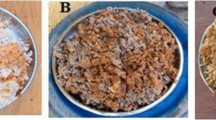Abstract
The optimal conditions of ethanol fermentation process by Zymomonas mobilis CHZ2501 were investigated. Brown rice, naked barley, and cassava were selected as representatives of the starch-based raw material commercially available for ethanol production. Considering enzyme used for saccharification of starch, the ethanol productivity with complex enzyme was higher than glucoamylase. With regards to the conditions of saccharification, the final ethanol productions of simultaneous saccharification and pre-saccharified process for 1 h were not significantly different. The result suggested that it is possible for simultaneous saccharification and fermentation as a cost-effective process for ethanol production by eliminating the separate saccharification. Additionally, the fermentation rate in early fermentation stage was generally increased with increase of inoculum volume. As the result, optimal condition for ethanol production was simultaneous saccharification and fermentation with complex enzyme and 5% inoculation. Under the same condition, the volumetric productivities and ethanol yields were attained to 3.26 g/L·h and 93.5% for brown rice, 2.62 g/L·h and 90.4% for naked barley, and 3.28 g/L·h and 93.7% for cassava, respectively.
Similar content being viewed by others
References
Reijnders, L. (2006) Conditions for the sustainability of biomass based fuel use. Energy Policy 34: 863–876.
Ezeji, T. C., N. Qureshi, and H. P. Blaschek (2004) Acetone butanol ethanol (ABE) production from concentrated substrate: reduction in substrate inhibition by fedbatch technique and product inhibition by gas stripping. Appl. Microbiol. Biotechnol. 63: 653–658.
Lawford, H. G. and J. D. Rousseau (2003) Cellulosic fuel ethanol: alternative fermentation process designs with wild-type and recombinant Zymomonas mobilis. Appl. Biochem. Biotechnol. 106: 457–469.
Lin, Y. and S. Tanaka (2006) Ethanol fermentation from biomass resources: current state and prospects. Appl. Microbiol. Biotechnol. 69: 627–642.
Chang, H. N., B. J. Kim, J. W. Kang, C. M. Jeong, N. J. Kim, and J. K. Park (2008) High cell density ethanol fermentation in an upflow packed-bed cell recycle bioreactor. Biotechnol. Bioprocess Eng. 13: 123–135.
Chen, L. J., Y. L. Xu, F. W. Bai, W. A. Anderson, and M. Moo-Young (2005) Observed quasi-steady kinetics of yeast cell growth and ethanol formation under very high gravity fermentation condition. Biotechnol. Bioprocess Eng. 10: 115–121.
Tsantili, I. C., M. N. Karim, and M. I. Klapa (2007) Quantifying the metabolic capabilities of engineered Zymomonas mobilis using linear programming analysis. Microb. Cell Fact. 6: 8.
Rogers, P. L., Y. J. Jeon, K. J. Lee, and H. G. Lawford (2007) Zymomonas mobilis for fuel ethanol and higher value products. Adv. Biochem. Eng. Biotechnol. 108: 263–288.
Zhang, M., C. Eddy, K. Deanda, M. Finkelstein, and S. Picataggio (1995) Metabolic engineering of a pentose metabolism pathway in ethanologenic Zymomonas mobilis. Science 267: 240–243.
Seo, J. S., H. Chong, H. S. Park, K. O. Yoon, C. Jung, J. J. Kim, J. H. Hong, H. Kim, J. H. Kim, J. I. Kil, C. J. Park, H. M. Oh, J. S. Lee, S. J. Jin, H. W. Um, H. J. Lee, S. J. Oh, J. Y. Kim, H. L. Kang, S. Y. Lee, K. J. Lee, and H. S. Kang (2005) The genome sequence of the ethanologenic bacterium Zymomonas mobilis ZM4. Nat. Biotechnol. 23: 63–68.
Rogers, P. L., K. J. Lee, and D. E. Tribe (1979) Kinetics of alcohol production by Zymomonas mobilis at high sugar concentrations. Biotechnol. Lett. 1: 165–170.
Sprenger, G. A. (1996) Carbohydrate metabolism in Zymomonas mobilis: a catabolic highway with some scenic routes. FEMS Microbiol. Lett. 145: 301–307.
Choi, G. W., S. K. Moon, Y. Kim, B. W. Jang, Y. R. Kim, and B. W. Chung (2008) Optimization of solid-state fermentation condition using distiller’s dried grain. Kor. J. Biotechnol. Bioeng. 23: 345–349.
Jeon, B. Y., S. J. Kim, D. H. Kim, B. K. Na, D. H. Park, H. T. Tran, R. Zhang, and D. H. Ahn (2007) Development of a serial bioreactor system for direct ethanol production from starch using Aspergillus niger and Saccharomyces cerevisiae. Biotechnol. Bioprocess Eng. 12: 566–573.
Swings, J. and J. De Ley (1977) The biology of Zymomonas. Bacteriol. Rev. 41: 1–46.
Choi, G. W., H. W. Kang, Y. R. Kim, and B. W. Chung (2008) Comparison of ethanol fermentation by Saccharomyces cerevisiae CHY1077 and Zymomonas mobilis CHZ2501 using starch feedstocks. Kor. Chem. Eng. Res. 46: 977–982.
Novozymes (2004) Application sheet: Enzymes that make glucose from liquefied grains. Novozymes, Bagsvaerd, Denmark.
Tsuey, L. S., A. B. Ariff, R. Mohamad, and R. A. Rahim (2006) Improvements of GC and HPLC analyses in solvent (acetone-butanol-ethanol) fermentation by Clostridium saccharobutylicum using a mixture of starch and glycerol as carbon source. Biotechnol. Bioprocess Eng. 11: 293–298.
Novozymes (1986) Industrial application sheet III. F-860973. Novozymes, Bagsvaerd, Denmark.
Nam, K. D. (1999) The Improvement of Processes for the Efficient Production of Alcohol. Ph.D. Thesis. Kyungpook National University, Daegu, Korea.
So, M. H., S. Y. Park, S. H. Kim, and H. J. Oh (1994) Conditions for the production of amylase and protease in marking wheat flour Nuluk by Aspergillus usamii mut. shirousamii S1. Kor. J. Food Nutr. 7: 51–57.
Nijssen, L. M., C. A. Visscher, H. Maarse, L. C. Willemsens, and M. H. Boelens (1996) Volatile Compound in Food. 7th ed., pp. 661. TNO Nutrition and Food Research Institute, Zeist, The Netherlands.
Motton, I. D. and A. J. Macleod (1986) Food Flavours: Part B, The Flavour of Beverages. pp. 239. Elsevier Science Publishers B.V., Amsterdam, The Netherlands.
Author information
Authors and Affiliations
Corresponding author
Rights and permissions
About this article
Cite this article
Choi, GW., Kang, HW., Kim, YR. et al. Ethanol production by Zymomonas mobilis CHZ2501 from industrial starch feedstocks. Biotechnol Bioproc E 13, 765–771 (2008). https://doi.org/10.1007/s12257-008-0184-3
Received:
Accepted:
Published:
Issue Date:
DOI: https://doi.org/10.1007/s12257-008-0184-3




